Unthinkable Consequences of US-Iran War
By Brig Narender Kumar (Retd)

Escalation of conflict between the US and Iran post assassination of Maj Gen Qassim Suleimani is inevitable. Retaliation from Iran is near certainty, but the question is will Iran confront the US militarily or will Iran employ its irregular assets that are spread across Asia and even Europe? Gen Suleimani was heading the Quds Force that has footprints across Asia and North Africa and had a tactical alliance with Popular Mobilization Force (PMF) of Iraq and Hezbollah of Lebanon. As a matter of fact, most Shia militias operating in Syria were controlled by Suleimani and his deputy.
The war in Gulf is set to destabilise already fractured West Asia and there is a possibility of widespread collateral damage to military and none military assets. If the US attacks Iran’s oil and critical infrastructure, Iran may choose to attack all the US assets including military bases, oil companies operating in West Asia, US multi-national companies and the US citizens. Iran has also stated that it will target even those nations that host the US forces or allow the US military to operate to target Iran.
The escalation is likely to drag Saudi Arabia and its allies into the conflict and will polarise already fractured Islamic world further. The Arab nations and people may not support Iran, but the US too does not enjoy support among the people of West Asia. Iraq, Syria, Saudi Arabia, Yemen, Qatar, and Iran itself will become part of battlespace even if some of the countries don’t wish to join the war.
The spillover effect of the conflict will be faced by Pakistan, Afghanistan, Turkey and North African nations. Pakistan will be under pressure from Saudi Arabia and the US to allow its territory to be used by them to effectively encircle Iran from east and northeast in case of hostilities. In such a situation there are chances that proxies of Iran may target Pakistan as well. This will assist secessionist forces in Baluchistan to align with Iran against Pakistan.
The global economic atmosphere is set to see the downward swing and many developing nations are likely to face a severe energy crisis. The conflict may affect close to 25 per cent of global oil supply. Similarly, the container traffic along the Northern Arabian Sea and the Red Sea will be impacted. Such a scenario will impact already struggling global economies.
In the past, the transnational terror organisations have exploited chaos and instability to establish a foothold and as a result, ISIS and Al Qaeda may see it as an opportunity to revive, reorganise and spread their sphere of influence. There is a likelihood of tactical alliances even between Shia militias and ISIS/ Al Qaeda against their common enemy the US and its allies. The war against ISIS will see abrupt discontinuation both by Iran backed militias and the US forces.
It may not be easy for the US companies to do business in the Middle East and North Africa (MENA) should the escalation takes place. In the long run, it will open up more new opportunities for China and Russia to forge deeper engagement with MENA. This will seriously impact the jobs and economy of the US.
One can’t deny members of Quds Force and Popular Mobilization Force already embedded with the refugees spread across Europe. If that happens the possibility of terror strikes in Europe may intensify. The US is unlikely to get engaged in ground conflict unless operational there is extreme urgency and necessity. The US forces will rely on technology and non-contact war.
The US and Iran war will seriously impact the Indian economy that is passing through a challenging period ahead. The energy security crisis will hamper the revival of Indian economy at a time when the industrial growth is dwindling and GDP has seen southward dip. Oil and gas supply from Gulf countries is likely to get disrupted, thereby directly impacting the economy. Indian expatriates remit approximately $70 billion to India and Gulf is one of the major sources of employment for skilled Indian workers.
India will also face the challenge of the evacuation of close to five million Indian diaspora from the affected nations. Therefore, India should start making contingency plans to extricate Indian Diaspora from the likely conflict zones. India would need to plan evacuation routes, transport, camps and requisite logistics support to keep evacuated people in staging areas till they are lifted out of the region by air, road and sea. India may be required to use, Europe, central Asia and even Africa before the conflict erupts in the region.
Apart from providing basic amenities, India would need massive logistic plans to provide food, medical, shelter, security and transport. India will be required to identify the vulnerable areas from where people would be required to be pulled out first. At the same time, it may be prudent to establish liaison offices now so that time is not wasted for preparation of the contingency plans.
This war may turn out to be an economic opportunity for Russia especially when the crude prices may rise. Russia and China will also find a market for their weapons and equipment as well. The US focus from Syria may shift to Iran, as a result, Russia will be able to consolidate its position in Syria and the Mediterranean Sea. China is likely to face some disruption in oil and gas supply and may even slow down work on its ambitious Belt and Road Initiative (BRI).
The trade war between the US and China may see a thaw and the US Indo- Pacific focus may be put on hold till the Gulf Quagmire gets resolved. However, this war is not likely to end any time soon and it may be a long haul for the US forces in Iran, Iraq and Syria.
*Author is a Distinguished Fellow, United Service Institution of India, New Delhi.
Views expressed here are personal.




